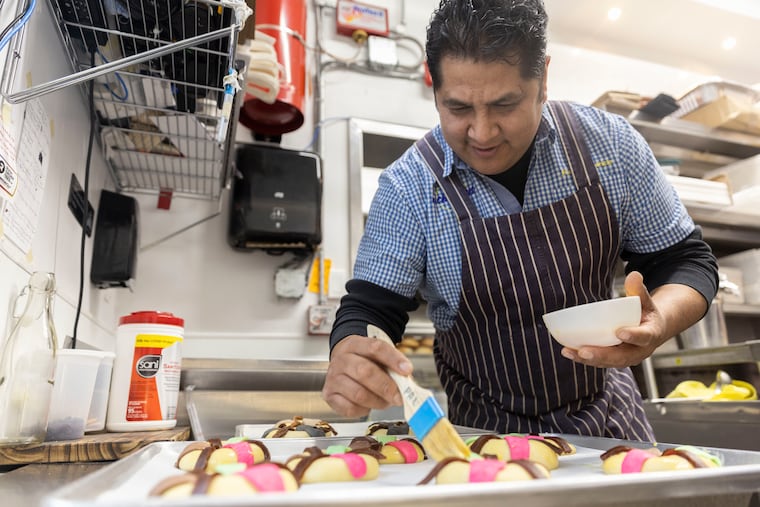How Philly’s Mexican community embraces and bends tradition making rosca de reyes bread
The traditional sweet bread is essential for those of Mexican heritage celebrating Three Kings Day on Jan. 6.

Adriana Salgado believes that her father’s recipe for rosca de reyes is the best one out there.
“The flavor, for me, is perfect,” she said.
Like many members of Philly’s Mexican community, she is from the Mexican state of Puebla, where her family owns a bakery. She grew up learning the finer points of baking from her father, including how to make rosca de reyes, or kings’ bread, a sweet, brioche-like bread usually made with different dried fruits on top, similar to a Mardi Gras-style King Cake.
The colorful, ring-shaped roscas are a core tradition for people of Mexican descent who celebrate Three Kings Day. Also known as Epiphany, the Jan. 6 Christian holiday marks the arrival of the three kings who visited Jesus after his birth.
Salgado is a caterer, and sells roscas every year for the holiday. She bakes them in her home kitchen in Northeast Philly, with each one taking four or five hours to make from start to finish. Then, she delivers them herself all across the city.
While making roscas is a business for Salgado, their religious significance stays with her. “This is really important [to] my family, because we are Catholic,” she said.
“When I talk about this, this is really with respect.”
Bending tradition
While Salgado prefers the traditional, vanilla-flavored rosca, Carlos Aparicio, the head chef and owner of the South Philly restaurant El Chingón, likes to experiment.
On one December afternoon as Aparicio planned for Three Kings Day, he prepared some smaller-sized roscas with chocolate topping and guava filing, and others with figs, cinnamon, and charcoal.
“It’s fun coming up with different types of ideas,” he said. “When it comes to baking, ideas never end.”
While Aparicio’s roscas are sized for individual portions, they still are ring-shaped, which is meant to symbolize infinite love for God. For the actual holiday, he is thinking about other unique flavors to infuse in his roscas at El Chingón, including some combination of rose petals, hibiscus, and herbs.
“Back in the day, it was very basic. You’d make a vanilla dough,” Aparicio said, recalling the roscas he would eat when he used to live in a small town in Puebla. “And then from that, some people started playing with different recipes, different ideas, adding different flavors.”
A constant for traditional roscas has been the use of acitrón on top, a dried cactus fruit that has been tossed in sugar and thinly sliced, like candy. This is where the color comes in, and the acitrón (sometimes nuts, too) represent the jewels on the crowns of the three kings. Traditional acitrón is now banned in Mexico after its popularity lead to the cactus becoming endangered, and most recipes use other dried, candied fruits instead.
Family and baby Jesus
When Araceli De La Cruz makes rosca de reyes in the bakery she and her husband own in South Philly, Catrina’s Cafe, she’s sure to include baby Jesus in the layers of sweet dough. Traditionally, roscas have tiny plastic babies hidden inside, meant to represent baby Jesus and how Joseph and Mary hid him from King Herod.
“Whoever gets the baby Jesus makes tamales [for a gathering],” she said, explaining another tradition that comes with roscas.
A classic rosca de reyes is large and meant to be shared, and might have a few plastic figures within it. At a family gathering, those who are lucky enough to grab a slice with a baby Jesus inside are supposed to make tamales and other feast-worthy foods for their family once they gather again on Feb. 2 for Día de la Candelaria, or Candlemas, a holiday representing when Jesus was presented at a temple in Jerusalem following his birth.
Even though it means more work for her, De La Cruz is usually happy if she finds baby Jesus inside of her piece of rosca. It’s another reason to spend time with her family and loved ones.
“We gather all together again,” she said.
Where to get rosca de reyes on Three Kings Day
Many Mexican bakeries across the city will have roscas available on Jan. 6; here are a few places that will either be selling them or giving them out for free:
Where: 1524 S. 10th St.
When: Beginning at 9 a.m. on Jan. 6, the restaurant will open to sell roscas de reyes, atoles, and coffee.
Where: 2001 S. Ninth St.
When: Catrina’s is selling roscas in store from Jan. 5 to 7, and will accept orders for roscas until Jan. 10.
Where: 2800 D St. and the Lighthouse Sports Complex at Front Street and Erie Avenue
When: In the morning ofJan. 6, Cantina La Martina will give away roscas at its Kensington restaurant. After 6 p.m., the restaurant will be holding a pop-up with more roscas at the Lighthouse Complex.
Where: You can contact Adriana Salgado and her catering company through its Facebook page, or her phone number, 267-500-3713, to place delivery orders for roscas de reyes.
When: Salgado is accepting orders for roscas through the holiday.